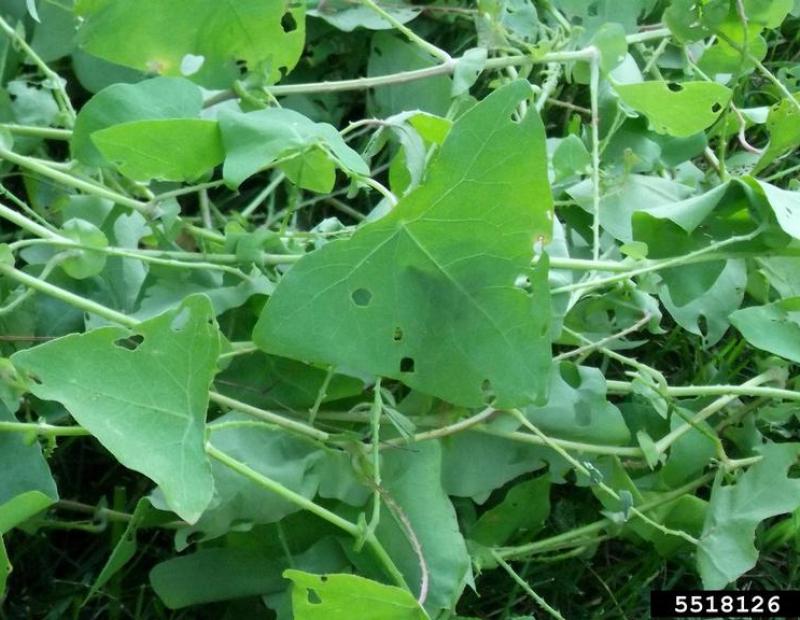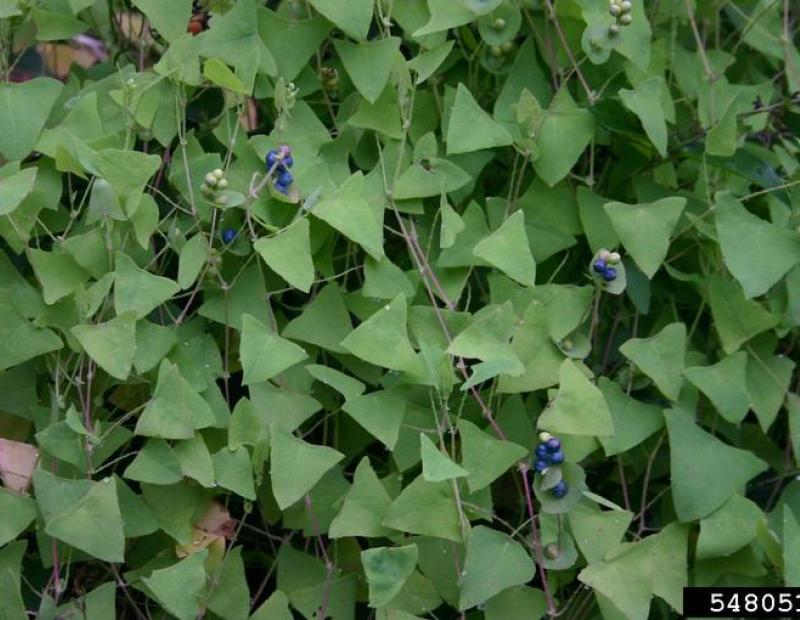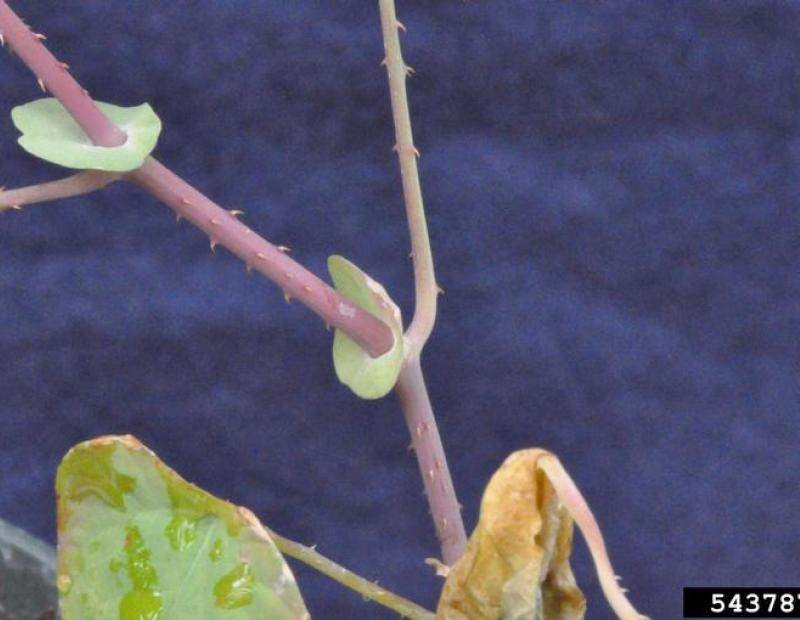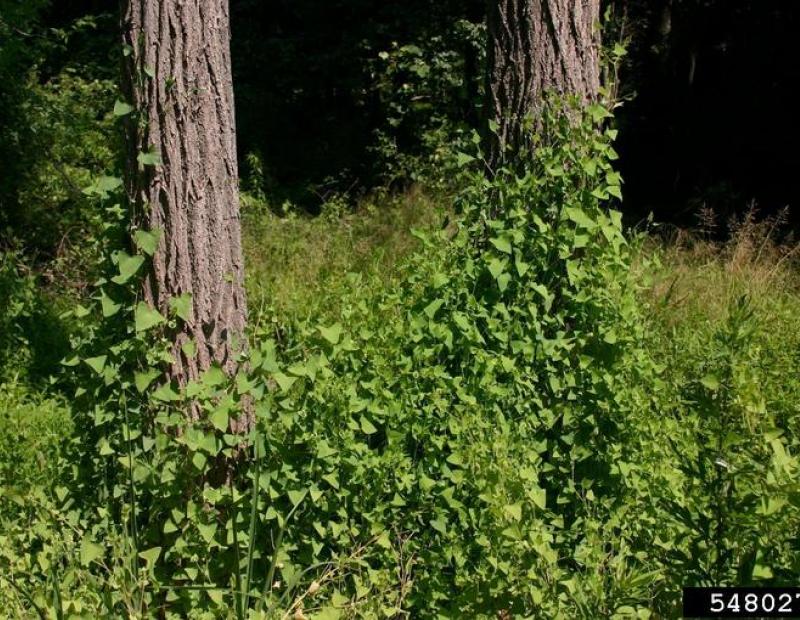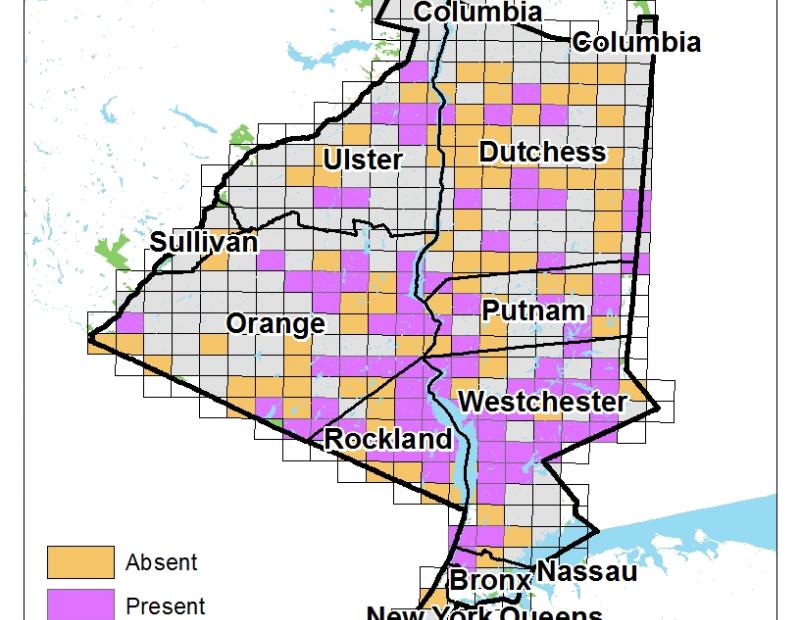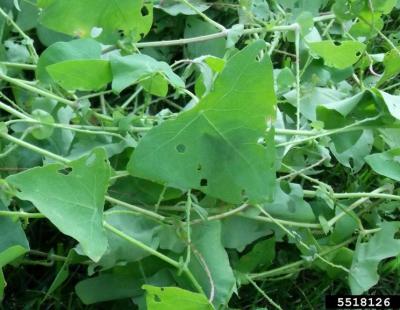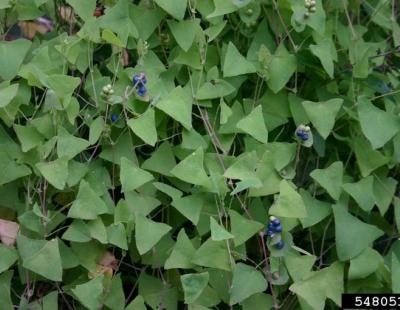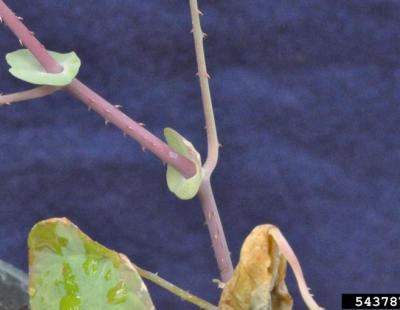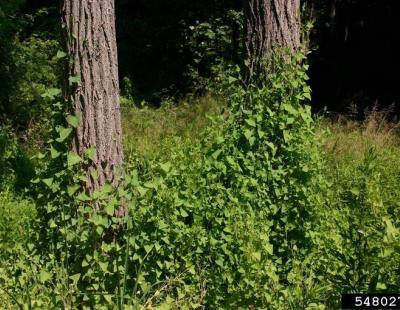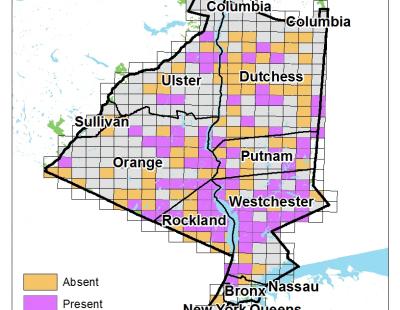Vertical Tabs
Mile-a-minute is a member of the Buckwheat family (Polygonaceae). It is a bright green, spiny, herbaceous annual vine capable of forming dense vegetative mats. Its bright blue berries, emerging towards the end of the summer, are perhaps the most conspicuous feature of the species. These fruits are arranged in long clusters in the axils of the leaves and contain a single, black, glossy seed. (3) Mile-a-minute is also highly visible in spring when broad, triangular, lime-green leaves begin to clamber over surrounding vegetation. (5). These leaves are distinctively triangular, hairless, and thin, with prickles on the midrib on the leaf’s underside. Sheathing ocrea, a saucer-shaped leaf-like structure, surround the stems at leaf nodes and are a good diagnostic feature of the species. (5) Mile-a-minute's flowers are inconspicuous and lack any showy petals. Arranged on a spike up to an inch long, flowers are found in the axils of the upper leaves, or at the terminal point of the plant’s vine. (5)
A spiny, herbaceous, annual vine, mile-a-minute gets its name from the celerity with which it grows. Capable of impacting the vegetative communities it invades from the canopy level down, mile-a-minute’s dense, smothering growth blocks light, limiting other plants’ ability to photosynthesize and germinate. In fact, mile-a-minute mats may be so thick they kill other thicket or mat-forming invasives such as Japanese honeysuckle. (2)
Biological Control
The Asian weevil (Rhinoncomimus latipes) has established populations throughout the Mid-Atlantic and New York and appears to impact Mile-a-minute’s competitive ability by decreasing annual growth and flowering. (3) For more information on biological control, please visit our mile-a-minute biocontrol website.
Manual or Mechanical Control
Pulling / Digging Up: Pulling by hand is an effective method of control for smaller populations of mile a minute. Gloves must be worn if undertaking this method due to the species’ sharp spines.
Mowing: Regular mowing, particularly in open areas will reduce or halt fruiting. (7)
Girdling: not applicable
Prescribed Fire: Little information is available on the efficacy of fire as a management tool for mile-a-minute. However, as a shallowly rooted annual vine it is likely a controlled burn would kill the vine.
Torching: Anecdotal evidence suggests torching may be a successful control method when done early in the season.
Prescribed Grazing: Not applicable
Soil Tilling: Tilling is generally not appropriate in the fragile, often moist soils mile-a-minute colonizes. However, this management strategy will eradicate infestations if performed before seed set. (2)
Mulching: Mulching may help reduce the seed bank and cover bare ground after infestations have been controlled via spraying and or pulling, however, this will also reduce the reestablishment of other, native vegetation in the area, too
Solarization: No information available
Hot Foam Spray: No information available
Chemical Control
The pesticide application rates and usage herein are recommendations based on research and interviews with land managers. When considering the use of pesticides, it is your responsibility to fully understand the laws, regulations and best practices required to apply pesticides in a responsible manner. At times, the pest you seek to treat may not be on a pesticide label, requiring a 2ee exemption from NYSDEC. Always thoroughly read the label of any pesticide and consult the NYSDEC or a licensed pesticide applicator with questions.
Foliar Spray: A 1-2% solution of glyphosate is effective at managing mile-a-minute, although repeat applications may be necessary. Infestations managed in this way should be revisited in 2-3 weeks to monitor for regrowth. Always read and follow all instructions on the herbicide label. (8)
Cut Stump: Not applicable
Basal Bark: Not applicable
Hack-And-Squirt
Stem Injection: Not applicable
Pre-Emergent Spray: Not applicable
General management overview and recommendation
As with any other invasive infestation complex, infestations of mile-a-minute are best managed via a combination of mechanical and chemical means. Small seedlings and plants can be hand pulled while larger shrubs must be sprayed to attain good control. All managed infestations should be monitored to ensure exhaustion of the seed bank for at least three years and to prevent reinvasion from nearby populations. Any new seedlings can be hand pulled or sprayed.
Post treatment monitoring
Any infestations managed by chemical means must be revisited in 2-3 weeks to check for treatment efficacy. Due to the long-distance dispersal mechanisms of mile-a-minute, managed infestations must be checked for reinvasion, particularly if the site is down river from known seed sources.
Disposal Methods
Waste material can be burned or composted so long as management was completed prior to seed set. Any fruit must be bagged and disposed of.
REFERENCES
- https://www.dec.ny.gov/docs/lands_forests_pdf/isprohibitedplants2.pdf
- https://www.fs.fed.us/database/feis/plants/vine/polpef/all.html
- https://www.cabi.org/isc/datasheet/109155
- https://plants.usda.gov/core/profile?symbol=pope10
- https://gobotany.newenglandwild.org/species/persicaria/perfoliata/
- https://www.cabi.org/isc/abstract/20073142083
- http://www.docs.dcnr.pa.gov/cs/groups/public/documents/document/dcnr_010...
- http://delawareinvasives.net/yahoo_site_admin/assets/docs/mileaminutewee...

